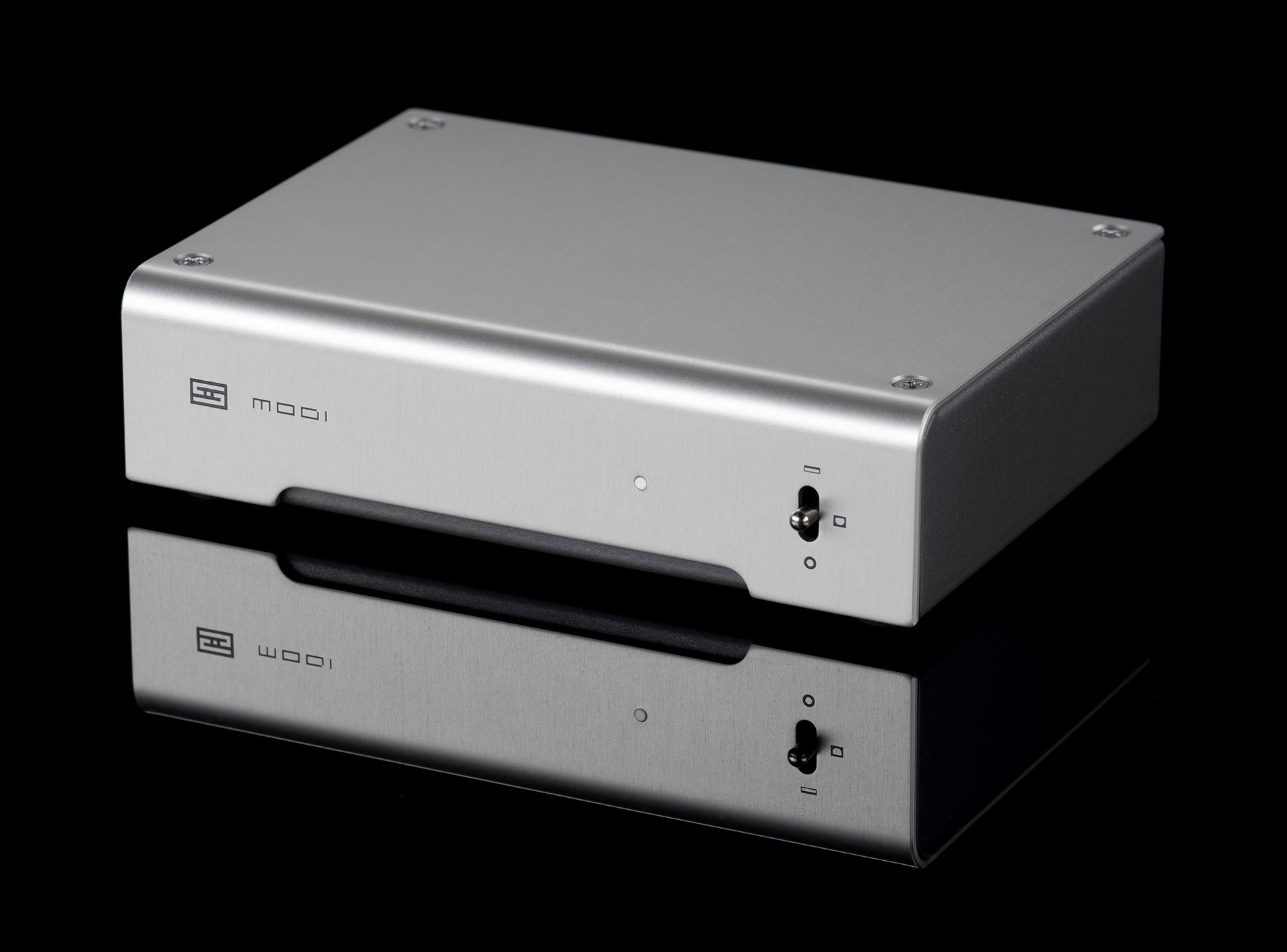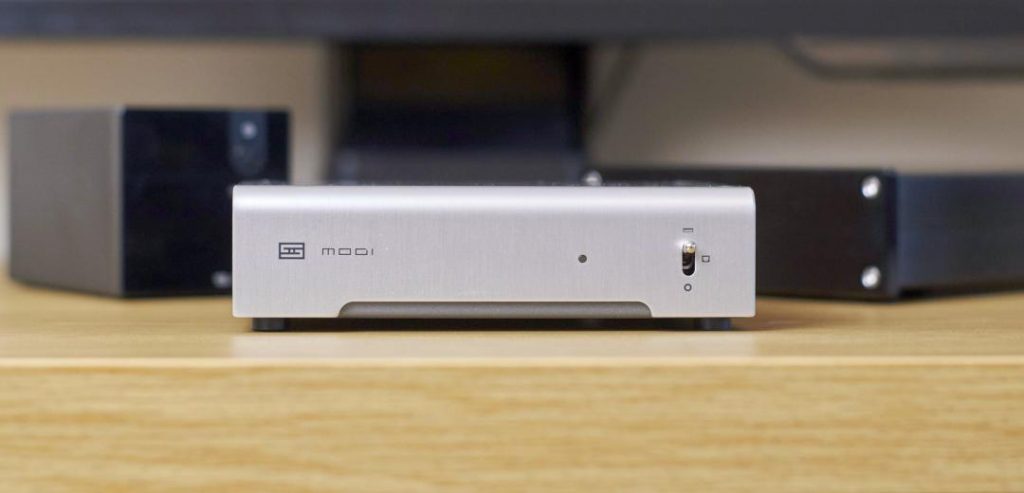I’ve been wanting to try a Schiit product for some time now, and the most logical place to start was a budget-friendly D/A converter – Modi 3. For those of you who don’t know – Schiit is a US-based company with all of their production also taking place in the US. Still, their entry model Modi 3 costs just $99 bucks which puts it directly against some very affordable models usually coming from China.
Schiit Modi 3 is centered around the Asahi Kasei Microdevices AK4490 DAC chip. Its format support is nothing to write home about. For example, there is no DSD support and PCM is supported to a 24 bit / 192 kHz max. In this little guy’s defense, that covers how we realistically consume the vast majority of our music. I simply don’t see the mass music industry accepting higher sample rates than 192 kHz any time soon. Why you ask. First of all because of a needed space which goes around 300~500 MB per 5 min of music. Secondly, because barely anyone can actually notice the difference between let’s say 192 kHz and 384 kHz. So do we really need a 384 kHz or DSD on a $99 DAC? I feel we don’t really. It’s just a bragging right and that’s all.
BUILD AND FUNCTIONALITY
On the outside, Modi 3 looks very clean and neat. It’s made of aluminum like most models are these days and it rocks a silver brushed aluminum look. The front panel is joined with a top cover over a stylish curve at the top edge. It’s somewhat different than most rectangular models with a thick front plate and I must say that I quite like it. The unit is decently heavy in my hand but when knocked it sounds hollow – that’s because the upper plate is not that thick like on some more expensive models.
On the back, we have a typical trio of inputs: USB, optical and coaxial. The second USB connector is used for an external power supply. You’ll need it only if you’re going to listen to music through optical or coaxial when Modi 3 is not connected to a PC. When it is connected to a PC, you don’t need an additional power supply. Just to be sure, I tried it both with and without an external power supply connected – I used the one provided in the box and I couldn’t hear any differences in sound quality.
On the front, there is just one switch to choose the input, accompanied by a bright white LED to indicate that the unit is powered. There is no power switch either and Modi 3 will stay on as long as the power is connected.
SOUND QUALITY
Talking about sound, Modi 3 is a very rounded and well-balanced performer. Bass is pleasantly full while at the same time being very well controlled and precise. It’s giving you plenty of information, edges, and texture of the bass notes. Moving on to the mid-range, it’s a pleasant surprise. There’s plenty of information to be heard, but even more, there’s a density to the tone that is so often overlooked in budget DACs. If you read or watched some of my other reviews you probably heard me complaining about the thin and overly edgy sound. I’m glad to report that’s not the case here. Modi 3 has that mid-range juice and density to make vocals and instruments sound natural and present.
If you thought Modi sacrifices clarity and fine details for the thickness – I’m happy to say that’s not the case. Quite the opposite actually, there’s plenty of extension and clarity in higher registers making it sound quite open. It can convey the sound of cymbals with great precision and reveal lots of tiny atmospheric details from the recording. To sum all this up shortly – the sound is characterized by the fast and precise bass, full tone and plenty of details.
The sound-stage is also very wide while depth is just adequate, not any better or worse than other DACs in the class. The sound is also well organized and quite smooth. It will hesitate to ever become too edgy, to jump and bite, which makes it a pleasant listen even during prolonged periods.
COMPETITION
To pair it against some price appropriate competition, I’ve decided to use SMSL M100 that I had at hand first. Overall dynamics were comparable, but it was clear that Modi 3 offers fuller and denser mid-range. It also resolves details easier, especially in the bass and mid-range region. Vocals, guitars, and most other instruments simply sound more digital with M100 compared to slightly more natural Modi 3.
The second comparison was made with my long-time favorite Khadas Tone Board. When you buy it, it’s just board without a case, so you’d have to buy a case separately. Now comparing Modi 3 to Khadas it’s clear they have a different approach. While Modi 3 sounds airy, spacious, and resolve details with more ease – Tone Board sounds darker, has weightier bass notes, and more dense midrange. The difference is more in character than it is in quality, and you may find yourself preferring one over the other depending on the rest of your system or personal taste. If pressed to choose one over the other, I’d probably go for Modi 3 though.
Finally, Loxjie D10 is slightly more expensive for US-based buyers, but might actually be cheaper for the rest of the world. This oddly shaped box is a tough competition. Its sound character is basically the same as Modi’s – fast, lively, and precise. That said, D10 is resolving details just a bit better than Modi. Depending on the price and availability in your region, both of these are a great buy.
CONCLUSION
Schiit Modi 3 is a neat looking device, it has 3 different inputs, and to my ears sounds better than any other DAC under the $100 mark. If you can get it for the $99 – I can’t imagine not giving this device a thumbs up. For those of you that are not living in the US, you would need to count in shipping and taxes. It may finally cost you somewhere around $150, as it did cost me. In that case, you should also consider other options like Loxjie D10, iFi Zen DAC or Topping E30.
| SCHIIT MODI 3 – CHARACTERISTICS |
| D/A converter: Asahi Kasei Microdevices AK4490 Supported formats: PCM up to 24 bit/ 192 kHz Digital inputs: 1 x micro-USB, 1 x coax, 1 x optical Analog outputs: 1 x RCA DNR: 104 dB THD: < 0.001 % Dimensions: 127 x 32 x 89 mm Weight: 454 g Price at time of testing: $99 |
| SCHIIT MODI 3 – CHARACTERISTICS |
| D/A converter: Asahi Kasei Microdevices AK4490 Supported formats: PCM up to 24 bit/ 192 kHz Digital inputs: 1 x micro-USB, 1 x coax, 1 x optical Analog outputs: 1 x RCA DNR: 104 dB THD: < 0.001 % Dimensions: 127 x 32 x 89 mm Weight: 454 g Price at time of testing: $99 |







Hi, I am in confusion to choose between Schiit MODI 3 and Topping E30. I haven’t experienced them in person but I am going by reviews and test / demo videos from youtube and these DACs I feel fit best for my budget. I want to use it with my “Nakamichi IA3 – Integrated Amp” and “Jensen 3103 3-way speakers”.
I request your recommendation on this.
I do have the following doubts & Concerns:
1. What is the universal name for the usb cable in MODI 3 to connect to PC/Laptop?
2. Topping E30 has more Remote controller dependency for controls. No separate physical buttons.
3. Modi 3 uses USB connectivity for power source as well, will it create any impact in sound output over period of time.
Hi Mohan! Let’s start with these:
1. It’s called simply micro USB cable… it has common USB-A on one side and micro-USB on the other one. Any micro-USB cable used to charge phones will do the job.
2. That’s right. E30 has only one touch-sensitive button that doubles as a power button and input selector. Everything else is done through the remote. On the other hand, Modi 3 doesn’t even have those additional functionalities in the first place, just an input selection switch and that’s it (you can do that on E30 without remote too).
3. Yes it does but the power input is separated from the signal one so there’s no negative impact on sound quality. It’s the separate power input, just using a USB jack instead of a typical 2.1/5.5mm power jack found on E30, their function is exactly the same.
Personally, I believe E30 is a better bang for the buck at the moment. Hope this helped. Cheers!
Hi Stojanovic
I really love the reviews you post..very detailed and extensive covering all the key aspects that ‘really matter’.
I was thinking of buying a dac to support my 2 channel set up comprising marantz stereo receiver and PSB alpha 5 speakers. I have the nx4 dsd and fiio q1 mkii portable dacs and have used them with the set up. However wanted to install a dedicated dac for music listening.
I am confused between the Schiit Modi Multibit, Schiit Modi 3 and Sanskrit 10th anniversary MKII. You mentioned that Sanskrit would be your 2nd choice after the multi bit. While both Modi 3 and Sanskrit are budget dacs (in my budget to be precise), the mimby is bit expensive and there is a long wait for me to get this back home (India). I am quite sensitive to sibilant sounds (tsst, chhss, etc. as you explained in one of the videos) and prefer smooth, inviting mids focused sound signature with reasonable resolution on the top
end. Usually prefer music genre like jazz, vocals, blues, soft rock.
So 2 questions where i wanted your views:
1. which one would you consider better when it comes to ‘relaxed’ between the 3. Would you consider Modi 3 and Sanskrit to be at par?
2. I understand from various reviews that mimby is a R-2R set up and has a better overall rounded inviting sound. Would you say the difference between Modi/Sanskrit MK II and the mimby is significant (bcz the price difference definitely is :))
Appreciate if you can reply
Thank you.
(Hoping you are doing well in COVID times and are safe and healthy!)
Hi Apurv,
Given that you’re not from US, same as myself, prices of Schiit gear pile up easily and they’re not as good purchase as in the US. Sanskit 10th MKII sounds fuller and livelier than Modi 3 to my ears and it’s probably much easier to get in your country. When it comes to Multibit, yes it has that really bold and warm sound signature that I like. But first of all, not everybody likes it. Secondly, for us not in the US it piles up to be something like 3 to 4 times more expensive than Sanskrit 10th and that makes it very difficult to recommend.
Thanks for the quick reply! Much more clearer on the choice now 🙂
– modi 3 vs Lusya Fever DAC (car DAC)? What is better? I’m use that with my iPhone X (usb). The both are compatible with the phone. I want the use on my car, I have a stock amp on my car.
-Do I need to use a passif preamp too with thoses DAC? Like the schiit sys or a cheap passif preamp? or the amp is enough? (with my phone on AUX, I need to put the volume 30/40 the be loud).
Thanks